A Boundary Timer Event object represents alternate workflow routing when a specified amount of time expires from the moment its associating object or connector triggers. The Boundary Timer Event object may associate with any of the following objects and connectors:
Form Task object
Script Task object
Manual Task object
Sub Process object
Actions By Email connector
Data Connector connector
DocuSign connector
IDP connector
PDF Generator connector
Send Email connector
The Boundary Timer Event object associates with an object or connector by attaching to it to that object or connector. Below a Boundary Timer Event object associates with a Form Task object.
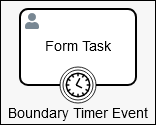
Boundary Timer Event object associates with a Form Task object
During an in-progress Request, if the object/connector to which the Boundary Timer Event associates has triggered but is not yet complete and the specified time expires for which the Boundary Timer Event object is set, then workflow routes through the Boundary Timer Event object.
After the associating object/connector triggers, the Boundary Timer Event object starts the set timer but does not trigger. The Boundary Timer Event object triggers only after the set time expires and its associating object has not completed.
Use an outgoing Sequence Flow object to indicate workflow routing from the Boundary Timer Event object if triggers.
Use a Boundary Timer Event object to design business solutions when intended or best-case workflow in your Request does not occur in an expected period of time. Consider these examples:
Escalate Task problems: When a Task assignee does not complete a Task when it is due, escalate to that assignee's manager to ensure project tasks are completed on schedule.
Script fail-safe: If a Script does not complete in a period of time, route workflow to a system administrator to investigate why the Script provided no response.
Escalate child sub-process problems: If the Request for a child Sub Process does not complete in a required period of time, route workflow to a manager's Task in the parent Process's Request so that the child Request does not delay the parent Request.
An object or connector associated with a Boundary Timer Event object may also associate with the following objects in the same object/connector:
Boundary Error Event object
Boundary Signal Event object
Boundary Conditional Event object
A Sub Process object associated with a Boundary Timer Event may also associate with a Boundary Message Event object.
Configure whether a Boundary Timer Event object interrupts the best-case scenario workflow:
Interrupting workflow: When workflow routes through the Boundary Timer Event object, workflow is interrupted and does not route through the best-case scenario. As highlighted in the example below, workflow routes through the Boundary Timer Event object if the Manual Task object does not complete within 30 minutes.
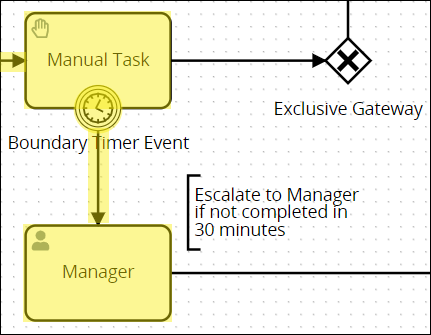
Non-interrupting workflow: Workflow routes both through the Boundary Timer Event object and the best-case scenario, thereby creating parallel workflow in that Request. As highlighted in the example below, workflow routes through the Boundary Timer Event object if the Manual Task object does not complete within 30 minutes; however, workflow also routes through the best-case scenario when the Manual Task object completes.
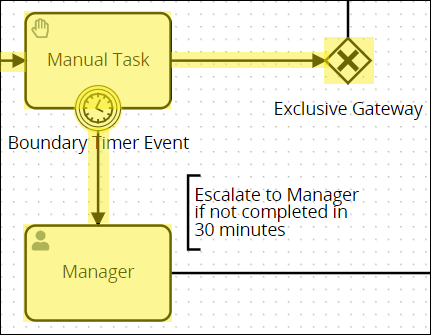
Processes that use Boundary Timer Event objects can be complex. Therefore, use it to test workflow variations while designing such Processes.
Add a Boundary Timer Event to the Process Model
Permissions
Your user account or group membership must have the following permissions to configure a Boundary Timer Event object in the Process model unless your user account has the Make this user a Super Admin setting selected:
Processes: Edit Processes
Processes: View Processes
See the Process permissions or ask your Administrator for assistance.
Follow these steps to add a Boundary Timer Event object to the Process model:
Add one of the following Process model objects or connectors to your Process model in which to associate with the Boundary Timer Event object:
Actions By Email connector
Data Connector connector
DocuSign connector
IDP connector
PDF Generator connector
Send Email connector
From the Boundary Events drop-down menu, select the Boundary Timer Event option.
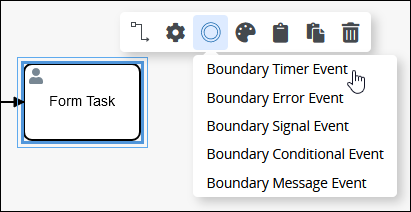 The Boundary Timer Event object displays on the top of its associating object/connector.
The Boundary Timer Event object displays on the top of its associating object/connector.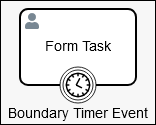
Settings
The Boundary Timer Event object has the following panels that contain settings:
Configuration panel
Timing Control panel
Advanced panel
Documentation panel
Configuration Panel Settings
The Boundary Timer Event object has the following settings in the Properties panel:
Edit the Object Name
An object name is a human-readable reference for a Process object. Process Modeler automatically assigns the name of a Process object with its object type. However, an object's name can be changed.
Follow these steps to edit the name for a Boundary Timer Event object:
Select the Boundary Timer Event object from the Process model in which to edit its name.
Ensure that the Configuration panel displays. If not, show it. The Name setting displays. This is a required setting.

In the Name setting, edit the selected object's name and then press Enter.
Interrupt the Best-Case Scenario Workflow
Indicate whether the Boundary Timer Event object interrupts the best-case scenario workflow:
Interrupting workflow: When workflow routes through the Boundary Timer Event object, workflow is interrupted and does not route through the best-case scenario. As highlighted in the example below, workflow routes through the Boundary Timer Event object if the Manual Task object does not complete within 30 minutes.
.png)
Non-interrupting workflow: Workflow routes both through the Boundary Timer Event object and the best-case scenario, thereby creating parallel workflow in that Request. As highlighted in the example below, workflow routes through the Boundary Timer Event object if the Manual Task object does not complete within 30 minutes; however, workflow also routes through the best-case scenario when that object completes.
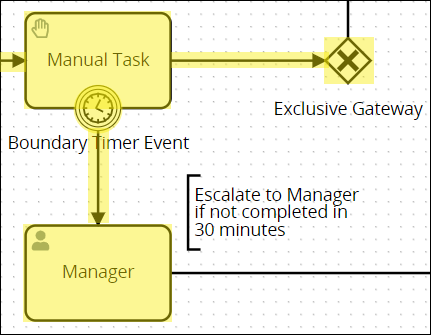
Follow these steps to indicate if this Boundary Timer Event object interrupts the best-case scenario workflow when it triggers:
Select the Boundary Timer Event object from the Process model in which to indicate if it interrupts the best-case scenario workflow. Panels to configure this object display.
Expand the Configuration panel if it is not presently expanded, and then locate the Interrupting setting.
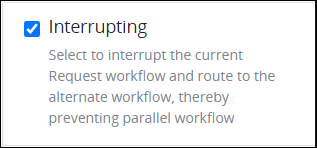
From the Interrupting checkbox, indicate whether this Boundary Timer Event object interrupts the best-case scenario workflow when it triggers. When the Interrupting checkbox is selected, which is the default setting, this object interrupts the best-case scenario workflow.
Timing Control Panel Settings
When a Boundary Timer Event object is placed into a Process model, it is set to trigger in one (1) hour before workflow routes through it unless its associative object completes before then. If this is not the timing control setting you want, the Boundary Timer Event object must be configured. Set the timer controls for a Boundary Timer Event object using one of the following methods:
Set an interval in which to delay routing workflow through the Boundary Timer Event object in a specified number of days, weeks, months, or years (unless its associative object completes before the delay expires).
Set the date and hour when the Boundary Timer Event object routes workflow through it (unless its associative object completes before that date and hour arrives).
Set the Timing Controls
Follow these steps to set the timer controls for a Boundary Timer Event object:
Select the Boundary Timer Event object from the Process model in which to set its timer controls.
Ensure that the Configuration panel displays. If not, show it. Panels to configure this object display.
Expand the Timing Control panel if it is not presently expanded. The Type setting displays.
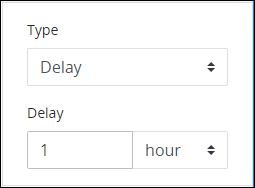
Do one of the following to set the timer control:
Set the timer when workflow routes through the Boundary Timer Event object: From the Type drop-down menu, select the Delay option. Delay is the default setting. From the Delay setting, select the delay to route workflow through the Boundary Timer Event object unless its associative object completes. 1 hour is the default setting. Then select one of the following time periods for that object to trigger:
Minute
Hour (default setting)
Day
Month
Set date and time when workflow routes through the Boundary Timer Event object: From the Type drop-down menu, select the Date/Time option. The Wait until specific date/time setting displays.

From the Wait until specific date/time setting, use the date control to select the date and time to route workflow through the Boundary Timer Event object unless its associative object completes. If this setting has not been previously set, the current date is the default.

Advanced Panel Settings
Edit the Node's Identifier Value
Process Modeler automatically assigns a unique value to each Process node added to a Process model. However, a node's identifier value can be changed if it is unique to all other nodes in the Process model, including the Process model's identifier value.
All identifier values for all nodes in the Process model must be unique.
Follow these steps to edit the identifier value for a Boundary Timer Event object:
Select the Boundary Timer Event object from the Process model in which to edit its identifier value.
Ensure that the Configuration panel displays. If not, show it. Panels to configure this object display.
Expand the Advanced panel if it is not presently expanded. The Node Identifier setting displays. This is a required setting.
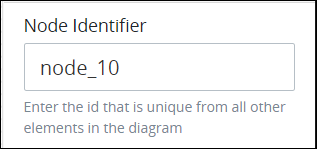
In the Node Identifier setting, edit the Boundary Timer Event object's identifier to a unique value from all nodes in the Process model and then press Enter.
Documentation Panel Settings
Describe the object's purpose and how it functions in the Process. This description does not affect Requests for the Process, but may be useful for Process model maintenance such as how the object is configured. Edit information by using the What-You-See-Is-What-You-Get (WYSIWYG) rich text editor.
A Process's entered documentation displays by selecting the View Documentation icon for that Process.
Edit the Object's Description Displayed in Process Documentation
Follow these steps to edit the description for an object:
Select the object from the Process model in which to edit its description.
Ensure that the Configuration panel displays. If not, show it. Panels to configure this object display.
Expand the Documentation panel if it is not presently expanded. The Description setting displays.
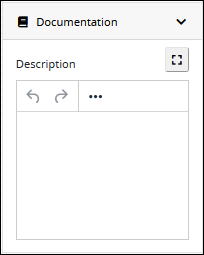
In the Description setting, edit the information to display when viewing documentation for this object and then press Enter. Alternatively, use the What-You-See-Is-What-You-Get (WYSIWYG) rich text editor to stylize your text by clicking the More icon
 .
.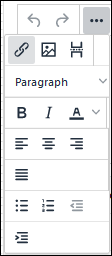
Follow these guidelines to use the WYSIWYG rich text editor to stylize your text:
Undo changes: Click on the
 icon to undo the last action.
icon to undo the last action.Redo changes: Click on the
 icon to redo the last undone action.
icon to redo the last undone action.Insert/Edit Link: Click on the
 icon to convert the selected text into a hyperlink. Follow these steps to create a hyperlink:
icon to convert the selected text into a hyperlink. Follow these steps to create a hyperlink: Select the required text from the Rich Text control.
Click on the
 icon. The Insert/Edit Link screen displays.
icon. The Insert/Edit Link screen displays.
In the URL setting, enter the destination URL.
In the Text to display setting, edit or enter the text displayed in the Rich Text control.
In the Title setting, enter the text to display when a user hovers over the displayed text.
From Open link in… drop-down menu, select one of these options:
New window: Select this option to open the destination page in a new browser window.
Current window: Select this option to open the destination page in the current browser window.
Insert/Edit Image: Click on the Insert/Edit Image icon
 to insert an image. Follow these guidelines:
to insert an image. Follow these guidelines: Click on the Insert/Edit Image icon
 .
. The Insert/Edit Image screen displays:

In the Source setting, enter a URL for the image.
In the Alternative Description setting, enter the text to display if the source URL of the image is not accessible.
In the Width setting, enter the maximum width for the image.
In the Height setting, enter the maximum height for the image.
Toggle the Constrain Proportions icon
 to maintain the width-height ratio of the image to its original proportion.
to maintain the width-height ratio of the image to its original proportion. Click Save.
Insert Page Break for PDF: Click on the Insert Page Break for PDF icon
 to insert a page break when a PDF document is created for this documentation if your browser supports this feature.
to insert a page break when a PDF document is created for this documentation if your browser supports this feature. Format text: Follow these guidelines to format text:
Headings: From the Paragraph/Formats menu, select Headings and then select a heading size.
Bold: Do one of the following:
From the editor toolbar, select the
 icon.
icon.From the Paragraph/Formats menu, select Inline and then Bold.
Italics: Do one of the following:
From the editor toolbar, select the
 icon.
icon.From the Paragraph/Formats menu, select Inline and then Italic.
Underline: From the Paragraph/Formats menu, select Inline and then Underline.
Strikethrough: From the Paragraph/Formats menu, select Inline and then Strikethrough.
Superscript: From the Paragraph/ Formats menu, select Inline and then Superscript.
Subscript: From the Paragraph/Formats menu, select Inline and then Subscript.
Code: From the Paragraph/Formats menu, select Inline and then Code.
Paragraph: From the Paragraph/Formats menu, select Blocks and then Paragraph.
Blockquote: From the Paragraph/Formats menu, select Blocks and then Blockquote.
Division: From the Paragraph/Formats menu, select Blocks and then Div.
Preformatted: From the Paragraph/Formats menu, select Blocks and then Pre.
Change text color: Use the Text Color drop-down to change text color. Click on the
 icon. The color palette displays. Do one of the following:
icon. The color palette displays. Do one of the following:Select one of the color swatches from the color palette. The selected text changes to that color.
Click the
 icon to select a custom color from the Color Picker.
icon to select a custom color from the Color Picker.Click the
 icon to reset the text to its default color.
icon to reset the text to its default color.
Align text: Follow these guidelines to align text:
Left align: Do one of the following:
From the editor toolbar, use the
 icon to left-align text.
icon to left-align text.From the Paragraph/Formats menu, select Align and then Left.
Center align: Do one of the following:
From the editor toolbar, use the
 icon to center-align text.
icon to center-align text.From the Paragraph/Formats menu, select Align and then Center.
Right align: Do one of the following:
From the editor toolbar, use the
 icon to right-align text.
icon to right-align text.From the Paragraph/Formats menu, select Align and then Right.
Justify: Do one of the following:
From the editor toolbar, use the
 icon to justify text.
icon to justify text. From the Paragraph/Formats menu, select Align and then Justify.
Insert a bullet list: Use the
 icon to format text as a bulleted list.
icon to format text as a bulleted list.Insert a numbered list: Use the
 icon to format text as a numbered list.
icon to format text as a numbered list.Indent text: Click on the
 icon to increase text indenting.
icon to increase text indenting.Outdent text: Click on the
 icon to decrease text indenting.
icon to decrease text indenting.